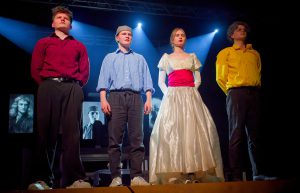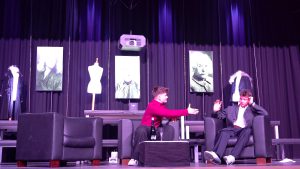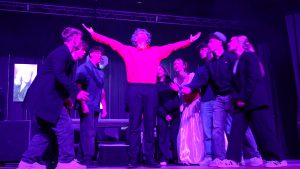
The Physicists - 2nd Performance on Tuesday, March 4th at 6 PM in the Forum
Hinweis: Dies ist eine automatische Übersetzung des Seiteninhalts (English). Für verbindliche Informationen gilt der deutsche Originaltext. Original anzeigen
Note: This is an automatic translation of the page content (English). For authoritative information, the German original text applies. Show original
Who is crazy here and who tells the truth? Can science save humanity or destroy it? – “The Physicists”, performed by the S4 theatre course of Mrs. Buchholz: 2nd performance on Tuesday, 4 March at 6 p.m.
As the forum is entered, the audience is greeted by pallid, mysterious light and two torsos, two female mannequin busts with a wooden rod for a head, on the left and right of the stage in front of the curtain already anticipating the crimes against innocent women, which will initially be at the forefront:
The curtain opens, music greets us and, from a bird's-eye view, we approach the scene of the action: the snow-white sanatorium Les Cerisiers, equipped with venerable columns, which, as Miss Dr. von Zahnd, the chief physician and proud heiress of the building and operations, says, is a “healing facility” or, as is commonly said, a complete “madhouse”!
Here are three physicists interned: “Isaac Newton”, “Albert Einstein” and the previously unknown, but particularly crazy-seeming Johann Wilhelm Möbius.
With the start of the action, the criminal police are once again on the scene: the madman who pretends to be Einstein has murdered his caregiver with a shower cord. While he calmly plays the Kreutzer Sonata in the adjacent room, the inspector, exasperated, finally demands better protection for the sisters, since “Newton” has already taken his caregiver’s life as well, while Miss Dr. von Zahnd declares that these two physicists are irradiated and not capable of responsible action, and that from the third, Möbius, no danger proceeds, which slowly makes the inspector doubt his own sanity.
The boundaries between madness, truth, science and freedom begin to shift, and as the course of the play continues it becomes clear why Dürrenmatt wrote it at the dawn of the Cold War between the USA and its traditional allies as well as the USSR and the Eastern Bloc: the atomic bomb as a cruel further development of Einstein’s theory of relativity as well as the fundamental insights of Newton made a potential nuclear war constantly present and had not long before been used in World War II.
Thus, the play chosen by the course members themselves is, under the direction of Mrs. Buchholz, brought to a crisp, pointed conclusion with great playfulness, a clear and expressive stage design, many succinct theatrical devices and ideas, and an impressive and entertaining performance especially of the physicists, the sisters and the chief physician, despite its 1961 publication date, again highly topical in times of brittle traditions:
Not only because of the dangers that unfortunately also today come from various dictatorial or autocratic atomic powers but also because of the warning that inventions and power, if in the wrong hands — think of AI, social media, deep fakes, satellites and space exploration today — can cause great harm.
At the end of the play there is also a known “Lost Place” shown on screen, which is once again hotly contested today: If you want to know which place this is and who are the ones with the all-powerful fantasies, be sure to attend the second performance on Tuesday, 4 March at 6 p.m. in the Forum!
A report by Johanna Wiesner





